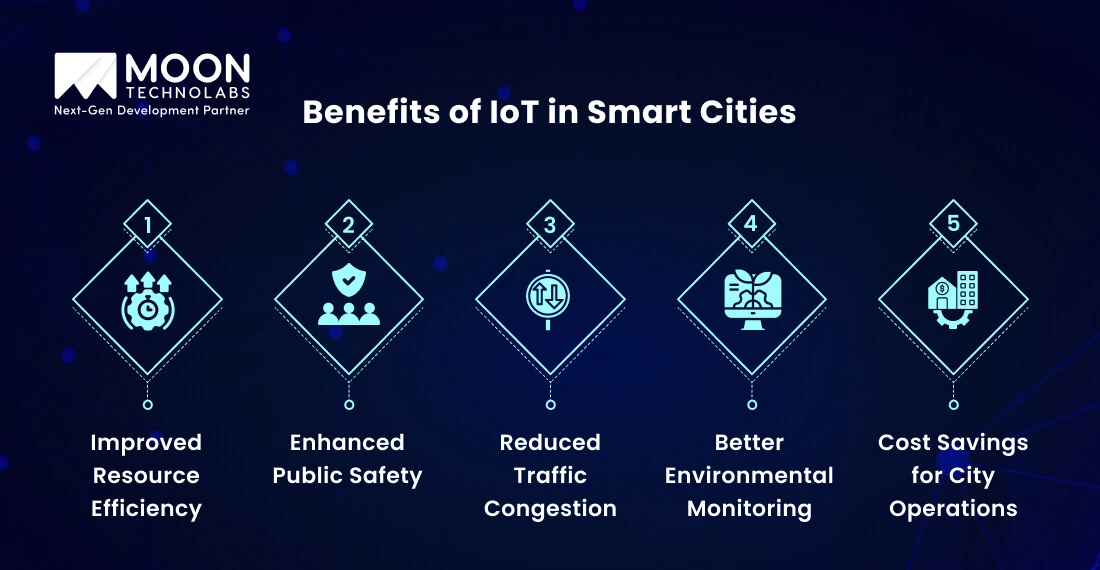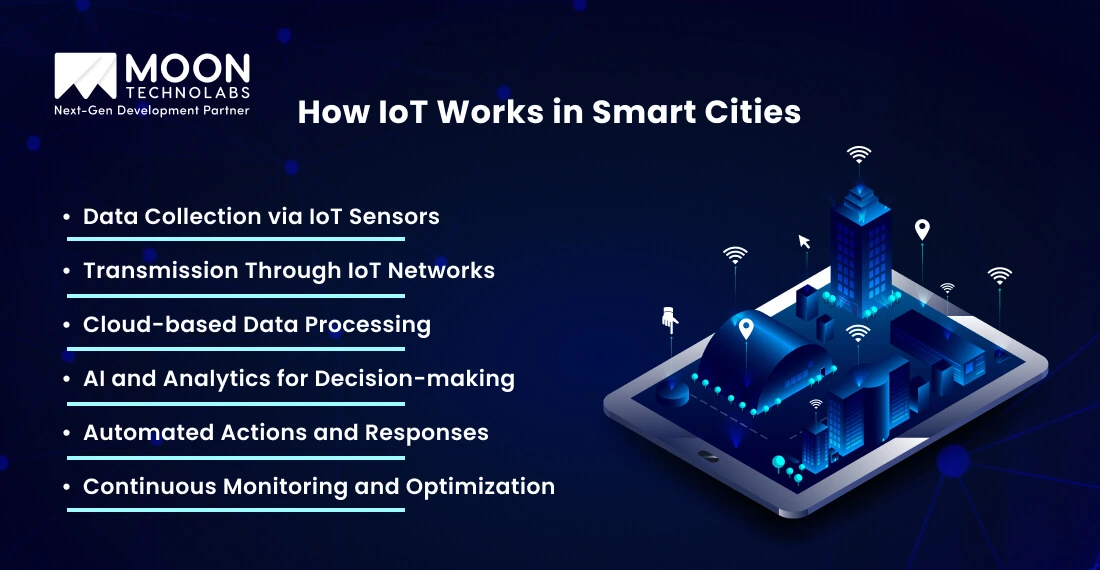Table of Content
Blog Summary:
IoT is indispensable in transforming traditional cities into smart cities through multiple connected devices and components. Do you want to explore everything in detail? This post is the right place for you. It explains the role of IoT in urban development, its benefits, use cases, work processes, and top trends in detail. Let’s explore now.
Table of Content
Due to extensive urbanization, cities have become densely populated. Whether small or large, they accommodate a large percentage of the population. This causes several issues, such as huge traffic congestion, waste management, and many others.
Municipalities face huge problems in sanitation, increasing energy consumption, environmental degradation, and more. IoT in Smart Cities is the right solution to these problems.
Municipalities of late are turning towards IoT for innovative city solutions. Due to this, its market size witnessed a major surge. As per a report by Markets and Markets, the global market size of IoT in smart cities is likely to reach $312.2 billion by 2026, which was only $130.6 billion in 2021
IoT has a great impact on urban life by making it more convenient while ensuring safety. The growing adoption of IoT in smart cities helps redefine infrastructure and public utility services.
In this post, we will take a look at the unmatched potential of IoT technology in developing smart cities.
Managing urban infrastructure efficiently is a major challenge. Smart cities must address problems such as public safety, conserving energy, and managing traffic.
IoT plays a vital role in urban development by improving sustainability, efficiency, and connectivity. Be it devices, smart sensors, or real-time data, the technology uses several components to redefine urban infrastructure.
IoT in smart cities provides safe environments, optimized energy use, smart healthcare services, and even public transportation systems. Real-time data collection aims to boost infrastructure, improve emergency response, and facilitate eco-friendly urban living.
These provide improved insights and make the interconnected ecosystem innovative and sustainable. Here’s how:
IoT is reshaping the operations of smart cities with IoT application development, enabling data-driven decision-making across industries.
Smart public transit systems use IoT to track real-time vehicle locations, improve route planning, and reduce delays.
Ride-sharing services rely on IoT for dynamic pricing and efficient fleet management.
Smart meters and grids help optimize energy consumption, reduce costs, and promote renewable energy usage.
By leveraging real-time data and automation, IoT improves city infrastructure and enhances residents’ quality of life, making urban areas more sustainable and responsive to modern challenges.
You Might Also Like:
Moon Technolabs Ranked as Top IoT Developers in USA by Techreviewer
There are several important components of IoT in smart cities for offering automation, smooth communication, and decision-making based on data. We have covered some of the components listed below;
Nowadays, smart cities use a huge network of actuators and sensors to gather real data from urban environments. IoT in energy management includes traffic monitors, air quality sensors, smart meters for utilities, and waste management sensors.
Actuators are responsible for responding to the data, which offers automated actions like optimizing energy consumption, adjusting traffic signals, activating emergency alerts, and more.
Connectivity is another necessary component for the Internet of Things in smart cities. It facilitates devices’ communication smoothly and allows for proper data exchange. Many connectivity technologies also support a variety of use cases.
Some of them include Low-Power Wide-Area Networks (LPWAN), 5G, Bluetooth, WiFi, and more. LPWAN is useful for environmental monitoring, smart parking, and more. It consumes less power.
Cloud computing is important mainly for storing and processing the larger amount of data collected through multiple IoT devices. These platforms are necessary for offering scalable infrastructure for handling real-time data analytics, remote device management, and integrating machine learning in IoT application development.
Smart city systems can use cloud computing to integrate different data sources and offer complete, actionable insights from disaster management and urban planning.
The power of smart city systems depends on AI and data analytics. Advanced analytics platforms can process vast amounts of data and offer traffic prediction, predictive maintenance, and environmental monitoring.
AI-based software solutions automate urban services with IoT in energy management, traffic management, smart waste collection, and personalized public services.
Privacy is highly important in smart cities, where many connected devices transmit sensitive data. Therefore, security solutions like blockchain, encryption, intrusion detection systems, authentication, and more must be implemented.
These offer data integrity and also protect against cyber threats. Implementing privacy policies and regulatory frameworks is necessary to ensure the safety of citizen data and thus maintain public trust.

The top advantages of IoT in smart cities are that it makes lifestyles better through connected devices and real-time data. It helps cities optimize their operations easily and thus enhance their services. Let’s explore some other important benefits;
The Internet of Things makes it possible to improve the management of necessary resources such as water, electricity, and waste. Smart grids are useful for controlling energy consumption.
Smart water meters can detect leaks, minimizing wastage. Automated waste collection systems can optimize garbage disposal routes, saving fuel and time.
Safety is another major advantage of IoT in smart cities. Many devices, such as smart streetlights, IoT-driven surveillance cameras, and emergency response systems, improve urban safety.
On the other hand, AI-powered video analytics in IoT application development can detect any unusual activity. Moreover, smart sensors facilitate fast emergency response.
Smart traffic management systems leverage real-time data to optimize traffic flow and minimize congestion by adjusting signals dynamically. Meanwhile, public transportation systems offer real-time updates to commuters, increasing travel efficiency as well.
The smart city concept also allows for improved environmental monitoring through its sensors for IoT in energy management. These sensors can track noise pollution, water, air, climate conditions, and more.
These ensure some proactive measures for enhancing environmental health. Cities can check pollution levels through sensors and thus can promote eco-friendly policies and regulations accordingly.
IoT automates city functions to minimize operational costs. Cities use smart lighting systems that can either turn off or dim based on the need. For instance, if there are no public streets, the system can turn off the light.
Therefore, it helps minimize overall energy expenses. It also ensures long-term savings through predictive maintenance for roads, bridges, and more.
Though we have already mentioned some of the popular use cases of IoT in smart cities, we will explore them in detail.
Smart traffic management systems are crucial to minimizing traffic congestion and maximizing transportation efficiency. Smart traffic lights have the potential to adjust signal timing according to real-time traffic laws.
On the other hand, GPS-based sensors offer highly accurate public transport schedules to commuters. IoT application development minimizes fuel wastage, adaptive parking solutions, and more.
Smart waste management systems include sensors to analyze waste levels. Based on this, IoT in energy management optimizes the finest route collections and minimizes fuel consumption and labor expenses.
Smart cities use data analytics to predict waste generation patterns and implement recycling initiatives. This effectively contributes to a clean environment.
IoT-powered smart grids can optimize energy distributions through consumption patterns and adjust supply accordingly. Smart meters offer real-time energy usage insights, allowing businesses and residents to minimize their carbon footprint.
Automated street lighting systems can adjust brightness according to occupancy, minimizing operational costs and energy wastage.
The Internet of Things makes city security foolproof in several ways, such as real-time crime monitoring, AI-powered surveillance, and smart alarm systems. Law enforcement can use CCTV cameras to find details of any suspicious activities.
These cameras include facial recognition. Improved crisis management and fast reaction times are other benefits of IoT-based emergency response systems.
Water scarcity has recently become a major concern. IoT in smart cities offers the right solutions to overcome this issue as well. Smart meters can easily find leaks and monitor consumption patterns.
Thus, it minimizes water wastage. Automated irrigation systems in public parks can adjust the water supply according to weather conditions, offering efficient water conservation.
Smart cities leverage IoT to improve healthcare accessibility. Remote patient monitoring devices track vital signs and send real-time health data to doctors, reducing hospital visits.
IoT-enabled emergency response systems ensure faster ambulance dispatch through automated traffic route optimization, improving survival rates in critical cases.

IoT works in smart cities in multiple steps, from data collection and cloud-based data processing to continuous monitoring and optimization. Let’s explore the necessary steps of how the entire system works;
In smart cities, sensors collect real-time data on a range of parameters. These include traffic flow, air quality, waste level, energy consumption, public safety, and more. Sensors are useful in parking meters, streetlights, environmental monitoring systems, and surveillance cameras. They are essential for collecting vital insights.
After the data is completed, IoT networks transmit it. These networks are pivotal for seamless data transfer from sensors to many cloud-based platforms, which is necessary for real-time monitoring and fast decision-making.
Cloud-based platforms can store and process data, which is then aggregated and structured properly for a complete analysis. The cloud-based infrastructure allows large-scale data management while offering both accessibility and scalability. It’s also necessary for IoT application development and integration with other smart city applications.
Data analytics and Artificial Intelligence tools are necessary to monitor the data collected from various IoT devices. AI-based algorithms can detect anomalies, identify patterns, and offer complete, actionable insights.
For instance, AI can easily predict traffic congestion and also suggest different options.
Smart cities use AI-based insights to automate responses to enhance efficiency. This is also essential to improving public services like traffic lights. Smart traffic lights can easily adjust based on traffic, and smart waste management systems can optimize collection schedules.
Continuous monitoring and optimization are essential for IoT application development in smart cities. They’re useful in analyzing infrastructure and services and thus also ensure real-time adaptability. Machine Learning algorithms can improve system performance over time, resulting in enhanced city management.
Several IoT trends revolutionize the concept of smart cities and thus improve urban living. We have provided a detailed list of some of the top trends.
AI and ML improve the overall capabilities of the Internet of Things, providing one-stop solutions for every need in smart cities. Whether optimizing energy consumption with IoT in energy management, predictive maintenance of infrastructure, or enhancing traffic management, AI-enabled surveillance systems make these all possible.
The launch of 5G networks has become crucial for various smart city usages. This technology can lower latency and offer ultra-fast speed to boost healthcare, smart transportation, public safety, and more.
5 G allows for the rapid processing of vast amounts of data, be it autonomous vehicles, real-time traffic monitoring, or smart grid management. It improves urban mobility.
Edge computing has changed the data processing procedure entirely by bringing computation closely to the source. It processes data locally rather than depending on centralized cloud servers, minimizing bandwidth usage and latency.
This is crucial for applications such as autonomous vehicles, smart traffic lights, environmental monitoring, and more.
Let’s discuss how IoT solutions can improve urban infrastructure and management in your city.
IoT has restructured traditional cities by ensuring seamless urban development, from AI-based decision-making and smart transportation to real-time monitoring. The emergence of technologies like edge computing, 5G, and AI integration makes the future of smart cities more promising.
We are an IoT development company at the forefront of this transformation by offering next-generation IoT solutions. At Moon Technolabs, we develop solutions that help cities enhance public services, optimize resources, and create a smart and sustainable future.
01
02
03
04
05
Submitting the form below will ensure a prompt response from us.